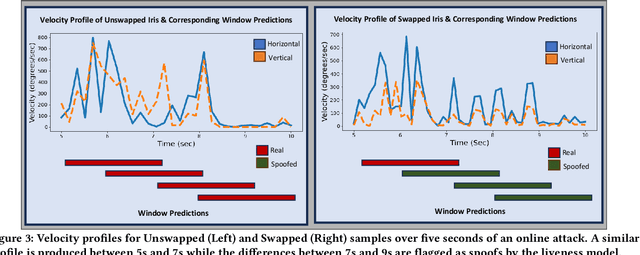Brendan David-John
Swap It Like Its Hot: Segmentation-based spoof attacks on eye-tracking images
Apr 22, 2024



Abstract:Video-based eye trackers capture the iris biometric and enable authentication to secure user identity. However, biometric authentication is susceptible to spoofing another user's identity through physical or digital manipulation. The current standard to identify physical spoofing attacks on eye-tracking sensors uses liveness detection. Liveness detection classifies gaze data as real or fake, which is sufficient to detect physical presentation attacks. However, such defenses cannot detect a spoofing attack when real eye image inputs are digitally manipulated to swap the iris pattern of another person. We propose IrisSwap as a novel attack on gaze-based liveness detection. IrisSwap allows attackers to segment and digitally swap in a victim's iris pattern to fool iris authentication. Both offline and online attacks produce gaze data that deceives the current state-of-the-art defense models at rates up to 58% and motivates the need to develop more advanced authentication methods for eye trackers.
Eye-tracked Virtual Reality: A Comprehensive Survey on Methods and Privacy Challenges
May 23, 2023



Abstract:Latest developments in computer hardware, sensor technologies, and artificial intelligence can make virtual reality (VR) and virtual spaces an important part of human everyday life. Eye tracking offers not only a hands-free way of interaction but also the possibility of a deeper understanding of human visual attention and cognitive processes in VR. Despite these possibilities, eye-tracking data also reveal privacy-sensitive attributes of users when it is combined with the information about the presented stimulus. To address these possibilities and potential privacy issues, in this survey, we first cover major works in eye tracking, VR, and privacy areas between the years 2012 and 2022. While eye tracking in the VR part covers the complete pipeline of eye-tracking methodology from pupil detection and gaze estimation to offline use and analyses, as for privacy and security, we focus on eye-based authentication as well as computational methods to preserve the privacy of individuals and their eye-tracking data in VR. Later, taking all into consideration, we draw three main directions for the research community by mainly focusing on privacy challenges. In summary, this survey provides an extensive literature review of the utmost possibilities with eye tracking in VR and the privacy implications of those possibilities.
 Add to Chrome
Add to Chrome Add to Firefox
Add to Firefox Add to Edge
Add to Edge